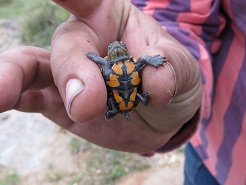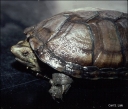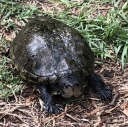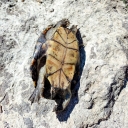Chihuahuan Mud Turtle (Kinosternon hirtipes)
Description: The rough-footed mud turtle, also known as the Big Bend mud turtle or Chihuahuan mud turtle. This small turtle with adults reaching about 7.5 inches.
Habitat: Lakes, rivers, streams, marshes, ponds in areas of mesquite and grassland.
Range: this species is known to inhabit only a short stretch of creek and a handful of cattle tanks fed by springs and wells in Presidio County. Most Texas populations are dependent on human-modified habitats (cattle tanks) that have largely replaced historic habitats (flowing streams).
Found in these States:
TX
Diet: As omnivores, the diet of K. hirtipes primarily consists of vegetation and insects including filamentous algae, seeds and fruits, aquatic, terrestrial, flying arthropods, as well as aquatic gastropods. K. hirtipes undergoes a dietary shift from insects to vegetation as body size increases which facilitates rapid growth. Although male K. hirtipes are larger in size than females, both sexes share a dietary overlap consuming similar foods.
Reproduction: Males grow faster and are larger than females by age five or younger. Females mature in six to eight years at 95-100 mm carapace length. Ovulation occurs from at least early May to late September. Given the lengthy reproductive season, evidence from multiple sets of corpora lutea and enlarged ovarian follicles suggests an annual production of four clutches. Egg width and mass correlate positively with body length and mass, and negatively with clutch size when the effects of carapace length are removed. Clutch size based on corpora lutea averages three eggs (range 1-6). Clutch size correlates positively with body length and mass. In Chihuahua, females mature in 6-8 years, lay several clutches (probably 4) in spring and summer; clutch size 1-6 (average 3).
Status: Ranges from southern Texas to southern Mexico; apparently stable in Texas but status is not well documented; has declined in at least some areas of Mexico; threats to Texas populations may include severe drought and killing by local landowners or leasees; the major threats to Mexican populations is pollution from sewage and industrial waste. and loss of habitat as more land comes under irrigation.
Subspecies: One in our Range
»» Kingdom: Animalia - Animals
»» Phylum: Chordata - Chordates
»» Subphylum: Vertebrata - Vertebrates
»» Class: Reptilia - Reptiles
»» Order: Testudines - Turtles & Tortoises
»» Family: Kinosternidae - Mud & Musk Turtles
»» Genus: Kinosternon
»» Species: Kinosternon hirtipes - Chihuahuan Mud Turtle
»» Subspecies: Big Bend Mud Turtle - ( Kinosternon hirtipes murrayi)
This article uses material from the Wikipedia article "Rough-Footed Mud Turtle", which is released under the Creative Commons Attribution-Share-Alike License 3.0. Content may have been omitted from the original, but no content has been changed or extended.
|








